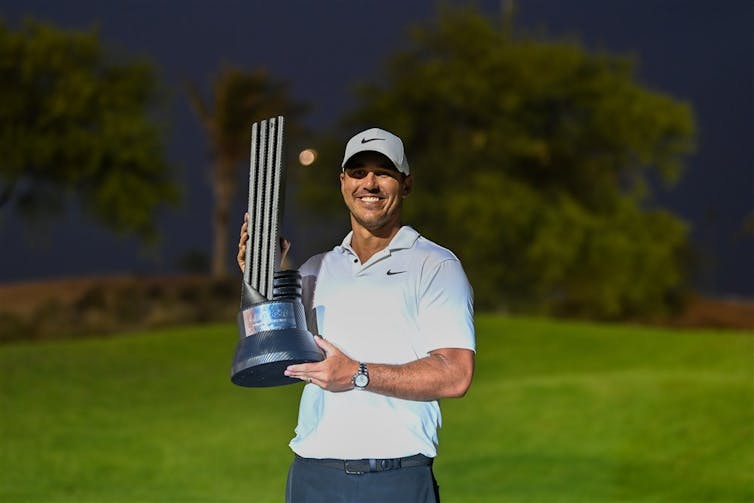They say a few months in sports can feel like a lifetime. In March 2023, just before golf’s first men’s major of the year, the Masters tournament, we explained in The Conversation how men’s professional golf had been shaken up by Saudi Arabia’s billion-dollar drive for legitimacy. This was via the introduction of LIV Golf in 2022, created by the Saudi Arabian Public Investment Fund (PIF).
Presented as an individual and team event, that is “golf but louder”, LIV tempted several of the PGA tour’s top players away. It’s easy to see why they were attracted: LIV offered astronomical signing fees and the chance to win up to US$4 million (£3 million) per event, the largest prize in golf.
In response, the PGA tour banned all professional players who played in the LIV from their tour and repeatedly decried the LIV tour as a sportswashing exercise by PIF and Saudi Arabia. There were also a number of legal battles between the two in 2023 and 2024 over claims of anti-competitiveness and financial legitimacy.
Read more: Saudi Arabia and sport: a strategic gamble aiming for economic, political and social goals
A shock “merger”, between the PGA tour, DP World tour and the LIV has now been announced, which represents a seismic shift for professional golf as a sport.
Given the acrimony, the change of heart shocked many, including a number of PGA tour golfers who felt blindsided. This even led to the US Senate opening an investigation into the drastic reversal of the PGA and the planned merger, which offered minimal details about the actual plan. We may never know the exact reasons why the bodies have joined forces, but we can hazard a guess at a few factors.
What has changed?
First, the product itself. The best product for men’s professional golf is one where all the best male golfers in the world compete against each other. Entering 2023, the men’s majors (the Masters, PGA Championship, US Open and the Open Championship) were the only place they could do this.
With the player split, however, every stakeholder had something to lose. The big moves to LIV (Brooks Koepka, Open Champion Cameron Smith, and other prominent names, including Dustin Johnson, Bryson DeChambeau and Phil Mickelson) cost the PGA tour in terms of prestige. They could no longer claim to host the strongest fields in men’s golf in their tournaments.

Likewise, LIV Golf was not making significant inroads into the PGA tours impact. They had some big names and big prize money, but no real sponsorship and no major television broadcasting deal.
A reported US$2 billion (£1.6 billion) investment was not seeing any returns.
Second, the power play and, of course, the money are reasons to “merge”.
The PGA tour had been offered similar deals with different equity partners but declined. Legal battles can prove costly and perhaps the PGA did not have the desire or the resources to keep this up.
In a business sense, the combination of entities actually makes some sense when you consider all these factors. It was also, perhaps, the only deal on the table. Money always talks, as the saying goes.
It’s not just about golf either. LIV Golf is part of a wider strategy, linked to Saudi Arabia’s Vision 2030. This blueprint, in part, looks to diminish Saudi Arabia’s reliance on oil by diversifying the economy and modernising its public services.
Read more: How Saudi Arabia came to be at the centre of a global golf merger
LIV may have started as the sideshow, but perhaps always had designs on being the main show. Or was LIV Golf just designed as a way to gain the Public Investment Fund (PIF) a seat at the top table of professional golf? Was it not designed for longevity but instead for disruption? LIV forced the PGA to make drastic changes that historically they were reticent to make. If that was the play, it was a smart one.
Who wins?
What comes next will be fascinating. The LIV Golf League’s status is currently unknown post the 2023 season. There will still be some player unrest that needs to be considered, especially for those who stayed loyal to the PGA Tour in the first instance. The players who defected to LIV now have the opportunity to apply to rejoin the PGA Tour in 2024.
Reports suggest that the PGA Tour will keep its position as a non-profit, tax-exempt organisation. A separate commercial entity will sit above the different tours. Who controls this in the future will dictate the landscape of golf in the future.
Currently, we only know that the new entity will include the PGA Tour’s commercial assets, the European DP World Tour and other golf-related commercial businesses of the Saudi Arabian Public Investment Fund. On paper, this looks great, but economic power cannot be ignored.
While the personnel involved in brokering the deal between the PGA and the PIF have stated that the PIF will only have first refusal to provide financial input, if the PIF can limit other investments and continue to buy unlimited shares, they basically have preemptive rights to the larger commercial entity. It is hard to imagine a scenario where the PIF would provide unlimited funds yet not be able to take control of their investments. Golf can still win out. As can the major stakeholders. Expect big investment and big egos to collide along the way, though.
The authors do not work for, consult, own shares in or receive funding from any company or organisation that would benefit from this article, and have disclosed no relevant affiliations beyond their academic appointment.
This article was originally published on The Conversation. Read the original article.







